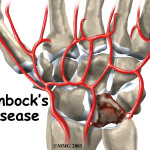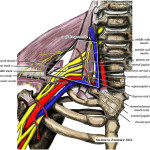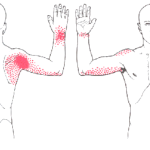Introduction
The sports physiotherapists reading this would be aware of the challenge of accurate diagnosis of hip pathology. The hip/groin area is an area with incredibly complex anatomy and biomechanics (Feeley et al., 2008). To quote a former anatomy lecturer of mine; “It is real tiger country!”. This means to improve clinical reasoning and diagnosis clinicians (and/or diagnosticians) must be acutely aware of the diagnostic accuracy of the clinical tests in their arsenal.
Labral tears in the hip are now becoming widely recognised as a source of anterior hip/groin pain and intra-articular pathology. The prevalence of acetabular labral tears in some populations presenting with hip or groin pain has been reported to be between 22% and 55% (Narvani et al., 2003; McCarthy et al., 2001). I think that is a WHOPPING percentage (and probably a bit high), but nonetheless it shows the frequency with which you will come into contact with these pathologies.
Identifying Labral Tears of The Hip
There are a number of clinical tests and subjective pieces of information that clinicians may associate with labral pathology of the hip. Fortunately Burgress and crew (2011) have performed a systematic review to identify the diagnostic accuracy of these clinical tests. The following sensitivities, specificities, positive and negative likelihood ratios have been calculated from their results.
Diagnostic Accuracy of Subjective Information
Anterior Groin Pain
- Sensitivity: 100%
- Specificity: 4%
- Positive LR: 1.04
- Negative LR: 0
- Sensitivity: 53 – 100%
- Specificity: Could not be calculated
Diagnostic Accuracy of Objective/Physical Tests
- Sensitivity: 75%
- Specificity: 43-100%
- Positive LR: 1.3 – ∞
- Negative LR: 0.01 – 0.58
- Sensitivity: 89%
- Specificity: 92%
- Positive LR: 11.13
- Negative LR: 0.12
- Sensitivity: 98%
- Specificity: Could not be calculated
- Sensitivity: 75%
- Specificity: 43%
- Positive LR: 1.32
- Negative LR: 0.58
Diagnostic Accuracy of Imaging
- Sensitivity: 63-100%
- Specificity: 71-100%
- Positive LR: 2.17 – ∞
- Negative LR: 0 – 0.52
- Sensitivity: 25 – 30%
- Specificity: 33 – 100%
- Positive LR: 0.67 – ∞
- Negative LR: 0.7 – 2.27
- Sensitivity: 92 – 97%
- Specificity: 87 – 100%
- Positive LR: 7.46 – ∞
- Negative LR: 0.03 – 0.09
Limitations of This Research
There are some significant limitation in this research, of which the authors are only too aware of. Overall, the quality of data from the included the studies was low. The articles were plagued by selection biases, small sample sizes, lack of blinding, and heterogenous populations (i.e. not all sports). These methodological limitations are displayed by the inability to establish specificity for some tests and additionally the wide range of values shown (e.g MRI Specificity 33 – 100%!). This clearly means that these results should be taken with significant caution and have questionable clinical implications.
Clinical Implications of This Research
What we can interpret from the research is:
- MRA consistently performs better than MRI and should be the first choice for imaging
- CT Arthrography was useful in diagnosing labral pathology
- Negative test results are of more use in ruling OUT the condition, given the high reported sensitivities of many tests
- A battery of tests should be utilised to improve the accuracy of your clinical reasoning
What are your experiences in the diagnosis of labral pathology of the hip? Be sure to let me know in the comments or catch me on Facebook or Twitter
If you require any sports physiotherapy products be sure check out PhysioSupplies (AUS) or MedEx Supply (Worldwide)
Photo Credit: jmd41280
References
Burgess RM, Rushton A, Wright C, Daborn C. The validity and accuracy of clinical diagnostic tests used to detect labral pathology of the hip: A systematic review. Manual Therapy 2011;16:318-326
Feeley B, Powell J, Muller M, Barnes R, Warren R, Kelly B. Hip injuries and labral tears in the national football league. The American Journal of Sports Medicine 2008;(36):2187-95.
McCarthy J, Noble P, Schuck M, Lee J. The Otto E. Aufranc Award: the role of labral lesions to development of early degenerative hip disease. Clinical Orthopaedics 2001;(393):25-37
Narvani A, Tsiridis E, Kendall S, Chaudhuri R, Thomas P. A preliminary report on prevalence of acetabular labrum tears in sports patients with groin pain. Sports Medicine 2003;(11):403-8.
Related Posts
Comments
Trackbacks
-
[…] Extremely well cited articles discussing the evaluation, assessment, and treatment of athletes including surgical approaches and their implications on rehabilitation. Their blog and website is maybe the most comprehensive sports physical therapy resource on the net. In this post, they review the diagnostic accuracy of tests used to identify Acetabular Labral Tears of the Hip. […]
-
[…] run on your toes. When you strike with your heel, it can cause hip pain.Powered by Yahoo! AnswersChris asks…Hip pain from running?hey, I’ve recently ran the 5 km Terry Fox run almost non-stop, ev…=”dtm-content”>Hip pain from running?hey, I’ve recently ran the 5 km Terry Fox run almost non-stop, […]










I am an ART provider.
I’ve found groin “pinching” with hip flexion to be extremely common, more than 50% of the patients I treat.
My rule of thumb is usually to treat the posterior hip capsule, hip external rotators, and adductor magnus for about 4 visits.
If results don’t last progressively from visit to visit, I refer for an MRA. But I’ve found that the majority of these symptoms are due to posterior capsule adhesions.
I would like to hear other opinions on this.
Thanks for sharing your findings!